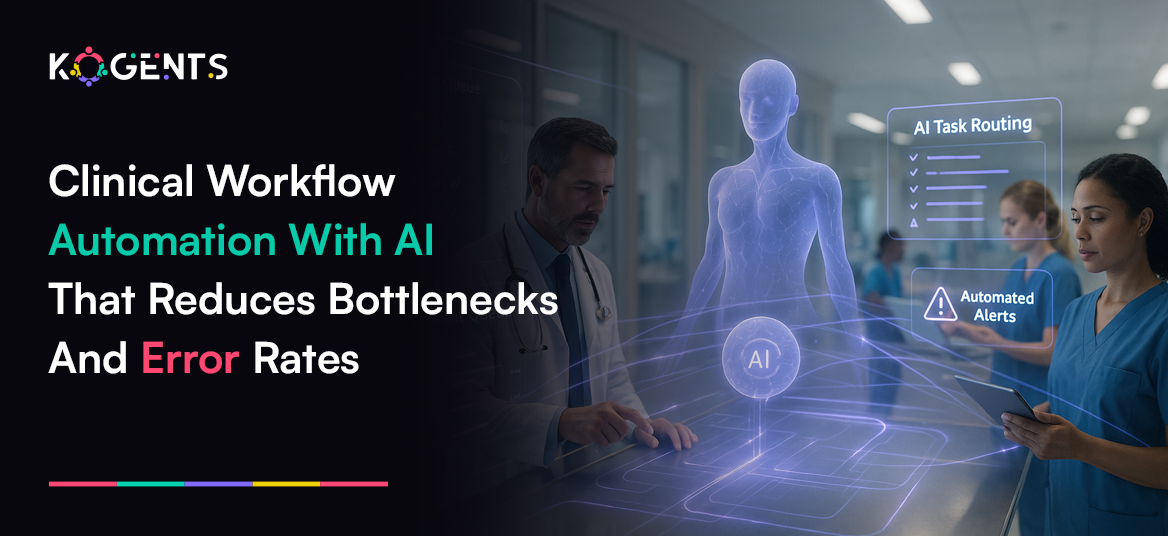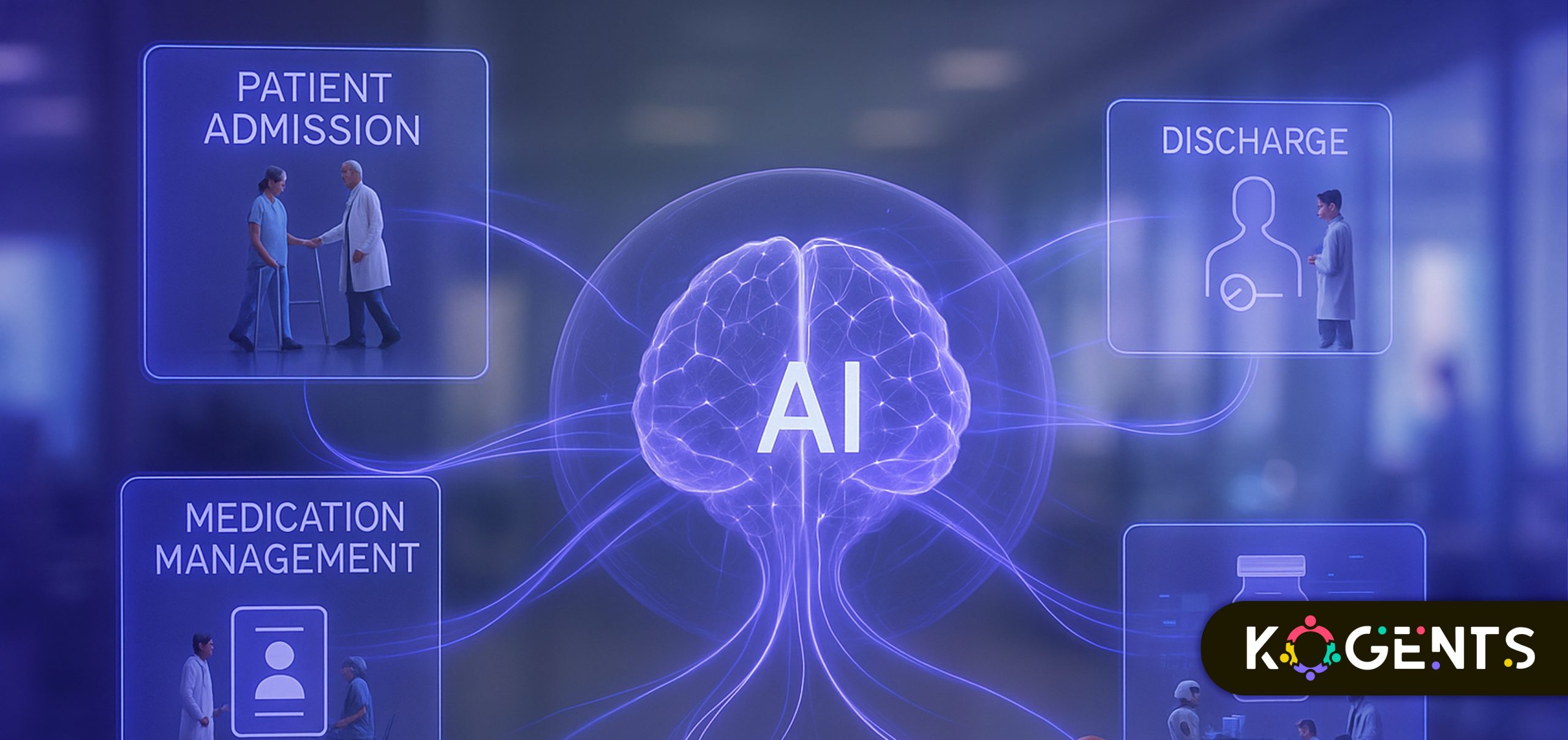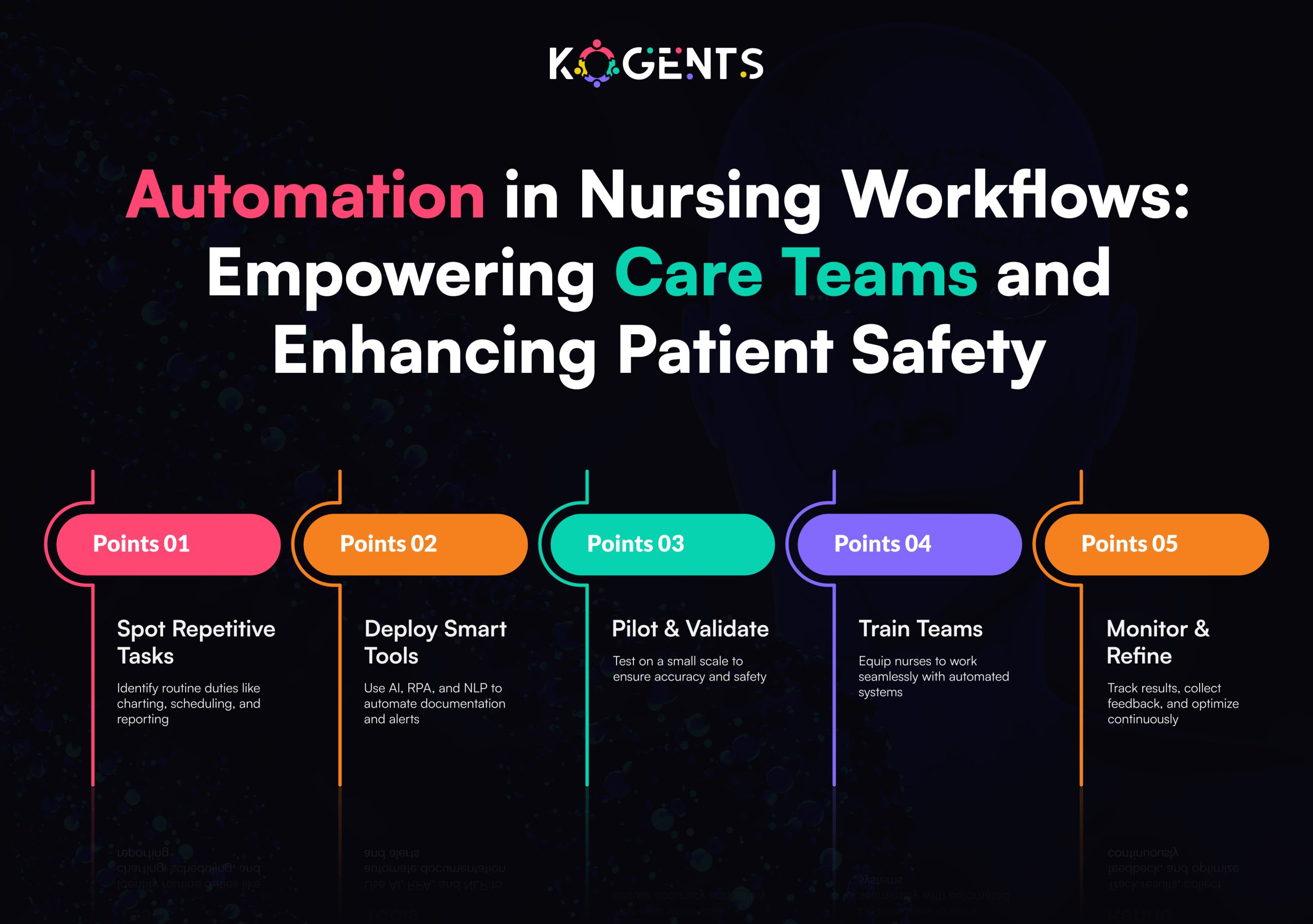Clinical workflow automation with AI that reduces bottlenecks and error rates

Summary:
The healthcare industry is under immense pressure to deliver faster, safer, and more cost-effective care, yet bottlenecks and human errors persist across hospitals, clinics, and outpatient settings.
The above fact depicts that manual documentation and inefficient workflows delay treatment and increase burnout rates.
With the adoption of clinical workflow automation, an AI-powered solution that streamlines repetitive clinical and administrative tasks, this has become hassle-free.
By integrating machine learning, robotic process automation (RPA), and natural language processing (NLP) into core hospital operations, healthcare organizations are transforming complex manual workflows into intelligent, adaptive systems.
This article explores how AI-driven clinical workflow automation minimizes bottlenecks, reduces error rates, and empowers care teams to focus on what matters most: patient outcomes.
Key Takeaways
- Understanding how AI-powered clinical workflow automation streamlines hospital operations.
- Learning how automation reduces errors, delays, and clinician burnout.
- Exploring the role of machine learning, RPA, and NLP in improving patient care.
- Discovering real-world examples of AI transforming healthcare delivery.
- Knowing how automation technologies prepare hospitals for future-ready, data-driven care.
What Is Clinical Workflow Automation?
It refers to the intelligent orchestration of using AI Agents for Healthcare Automation and automation technologies to reduce manual intervention.
Unlike basic digitization, it connects EHR systems, clinical decision support systems (CDSS), and hospital management platforms to perform rule-based tasks autonomously.
Modern automated clinical workflows rely on:
- Robotic Process Automation (RPA) for repetitive administrative tasks.
- Machine Learning (ML) for predictive analytics and resource optimization.
- Natural Language Processing (NLP) for real-time documentation.
- Interoperability standards like FHIR and HL7 for seamless data exchange.
Key Points You Need To Ponder Upon: This integration creates a connected ecosystem that spans patient scheduling, lab reporting, medication management, and clinical documentation automation, ensuring consistent accuracy and efficiency across departments.

The Problem: Bottlenecks and Errors in Traditional Clinical Workflows
Healthcare organizations worldwide face workflow inefficiencies that compromise patient care and staff well-being:
Manual data entry in EHRs
- Clinicians often spend hours entering information by hand, increasing the risk of typos, missing details, and inconsistent AI patient scheduling records.
- These errors delay decision-making and reduce time spent on direct patient care.
Paper-based workflows
- When departments still rely on paper charts or printed reports, vital information can be misplaced or delayed.
- This creates communication gaps, leading to duplicated efforts and delayed treatments.
Inefficient scheduling
- Poorly coordinated appointment systems cause patient no-shows, long wait times, and resource conflicts among staff and facilities.
- The result is reduced productivity and frustrated patients.
Unstructured documentation
- Free-text notes and scattered data make it difficult to extract insights for audits, compliance reporting, and quality improvement.
- This lack of structure slows down regulatory reviews and data-driven decision-making.
Staff overload from redundant tasks
- Clinicians often perform repetitive administrative duties that technology could easily automate.
- The extra workload contributes to burnout, lower morale, and higher turnover rates in healthcare teams.
| According to the Centers for Medicare & Medicaid Services (CMS), workflow inefficiencies cost U.S. hospitals billions annually and contribute significantly to diagnostic delays and preventable errors. |
Without automation, these bottlenecks limit scalability, drain resources, and diminish patient safety.
That’s why healthcare leaders are turning to AI-powered clinical process automation to reengineer operations from the inside out.
| Workflow Aspect | Manual Process | Automated (AI) Process |
| Data Entry | Time-consuming, error-prone | Instant and accurate through RPA |
| Scheduling | Prone to delays and overlaps | Optimized using predictive analytics |
| Documentation | Unstructured, inconsistent | Real-time NLP-based structured entry |
| Staff Efficiency | High workload and burnout | Reduced admin burden, higher productivity |
| Patient Safety | Prone to human error | Improved through real-time alerts |
How AI Enhances Clinical Workflow Automation?
AI takes healthcare workflow automation to a new level by making it adaptive, predictive, and context-aware, extending its value into areas like remote health monitoring and predictive patient management.
A. Intelligent Process Automation (IPA)
By merging RPA with AI, hospitals can automate both repetitive and decision-based tasks.
Example: AI models can analyze patient eligibility data to automatically process insurance pre-authorizations, reducing turnaround times by up to more than half of the total.
B. Predictive Analytics for Resource Management
- Machine learning models anticipate patient admissions, staff availability, and bed occupancy.
- Hospitals using predictive workflow automation can dynamically adjust staff schedules, preventing overwork and minimizing idle resources.
C. NLP in Clinical Documentation Automation
- NLP algorithms transcribe, summarize, and structure physician notes in real time, automatically updating EHR workflow automation systems.
- This improves medical documentation accuracy and reduces charting time by half.
D. Machine Learning for Decision Support
- AI-powered clinical decision support systems (CDSS) analyze historical data and flag abnormal results instantly.
- This enhances diagnostic accuracy and speeds up treatment recommendations.
- Collectively, these technologies build a learning healthcare system, one that continuously optimizes its workflows using real-world performance data.
Benefits of AI-Driven Clinical Workflow Automation
The impact of clinical workflow automation extends beyond operational gains; it reshapes the entire healthcare delivery model.
A. Eliminates Bottlenecks
Automated routing of test results, task assignments, and patient data ensures that every process moves smoothly through the care continuum.
B. Reduces Errors
AI validation algorithms prevent manual entry mistakes and trigger alerts when inconsistencies are detected in patient records.
C. Enhances Clinician Efficiency
By automating administrative load, clinicians reclaim valuable time for direct patient care, a critical factor in reducing burnout.
D. Improves Patient Safety
Automated alerts, predictive monitoring, and data-driven triage systems ensure timely interventions and fewer preventable incidents.
E. Increases ROI and Scalability
Hospitals implementing automation in clinical operations report much and more fast throughput and have fewer documentation errors.
These gains translate to better patient experiences, happier staff, and measurable financial sustainability.

Real-World Applications of Clinical Workflow Automation
Automation isn’t theoretical; it’s already transforming hospitals and clinics globally.
A. Radiology Workflow Automation
B. EHR Data Management
Platforms such as Epic Systems and Cerner (Oracle Health) employ AI-based data extraction tools that sync clinical notes and lab results seamlessly into EHR systems.
C. Operating Room and Bed Management
Predictive analytics tools forecast surgery durations, optimize room usage, and coordinate with sterilization units, improving surgical throughput.
D. Outpatient & Telehealth Automation
Athenahealth and Philips Healthcare leverage AI to automate virtual check-ins, patient follow-ups, and referral workflows, ensuring consistent care continuity.
Outcome: These real-world examples show how AI tools for clinical workflow optimization bridge the gap between technology and human care.
Implementation Challenges and Best Practices
Despite its potential, implementing healthcare workflow automation comes with hurdles.
A. Interoperability Barriers
- Many legacy systems lack integration with modern AI or RPA tools.
- Adopting FHIR and HL7 standards ensures smooth data flow across systems.
B. Compliance and Data Security
Hospitals must align with HIPAA, ISO 9001, and FDA regulations to maintain data integrity and patient privacy.
C. Change Management
- Staff may resist automation, fearing job loss.
- Transparent communication and incremental pilot projects ease adoption.
D. Cost and Scalability
Automation requires upfront investment, but ROI is proven through faster workflows, reduced errors, and long-term savings.
Best practice: Start small, measure success metrics, and scale to full hospital-wide automation over time.
The Future of Clinical Workflow Automation
The future of digital transformation in healthcare lies in autonomous, data-driven ecosystems.
Next-generation automation will feature:
- Generative AI for automated care summaries and report drafting.
- IoT integration for real-time patient monitoring and workflow synchronization.
- Interoperability-driven care using FHIR, HL7, and open APIs.
- Ethical AI governance frameworks ensure transparency and fairness.
As healthcare moves toward precision and personalization, AI-powered clinical workflow automation will serve as its digital backbone.
Wrapping Up!
Clinical workflow automation is redefining what operational excellence looks like in modern healthcare.
Through AI, RPA, and intelligent analytics, hospitals can reduce errors, remove bottlenecks, and empower clinicians to deliver safer, faster, and more compassionate care.
Automation doesn’t replace the human touch; it amplifies it, allowing healthcare professionals to focus on healing rather than handling paperwork.
For forward-thinking healthcare leaders, adopting AI in clinical operations isn’t optional; it’s the key to sustainable, scalable, and patient-centered care. So, visit us at Kogents.ai by calling us at +1 (267) 248-9454 or dropping an email at info@kogents.ai.
FAQs
What is clinical workflow automation?
Clinical workflow automation uses AI and RPA to streamline administrative and clinical tasks like data entry, patient scheduling, and reporting. It improves efficiency, reduces human error, and enables faster patient care delivery.
How does AI improve hospital workflows?
AI analyzes workflow data, predicts patient flow, and automates repetitive tasks, reducing delays and optimizing resource use across hospital process automation systems.
What are the benefits of automating clinical documentation?
Automating clinical documentation reduces transcription errors, improves EHR data accuracy, and saves clinicians hours each week through NLP-powered note-taking tools.
How can workflow automation reduce clinician burnout?
By handling repetitive data entry and paperwork, clinical process automation helps clinicians focus on patient interactions, lowering stress and burnout rates.
What are the best AI tools for clinical workflow optimization?
Leading platforms include Epic Systems, Cerner (Oracle Health), Athenahealth, Philips Healthcare, GE Healthcare, and IBM Watson Health. Each offers AI-driven modules for workflow management, CDSS, and EHR integration.
How can hospitals integrate AI into clinical workflow management systems?
Hospitals can integrate AI by ensuring EHR interoperability through FHIR/HL7, deploying RPA bots, and using AI APIs to link predictive analytics with healthcare IT systems.
What are the main challenges in automating healthcare workflows?
Challenges include interoperability issues, HIPAA compliance, data security, and resistance to change. Proper governance and staff training mitigate these barriers.
How does automation improve patient safety?
AI-driven alerts and clinical decision support systems detect anomalies early, reduce documentation errors, and ensure faster interventions, improving patient safety outcomes.
Which departments benefit most from healthcare workflow automation?
Automation delivers the greatest impact in radiology, pathology, pharmacy, and telehealth — optimizing diagnostic speed, lab throughput, and medication management.
What should hospitals consider when comparing automation vendors?
Hospitals should assess EHR compatibility, AI capabilities, compliance certifications (HIPAA, FHIR, ISO 9001), and scalability when choosing a clinical workflow automation platform.

Kogents AI builds intelligent agents for healthcare, education, and enterprises, delivering secure, scalable solutions that streamline workflows and boost efficiency.